Liquorice
The use of the Liquorice plant was first learnt by the Hellenes from the Scythians; and the root was named adipson, being thought from the time of Theophrastus to powerfully extinguish thirst.
Added Sep 9, 2010
| 5,697 Reads
The common Liquorice plant, a native of the warmer European countries, was first cultivated in Britain about 1562, in Turner's time. It has been chiefly grown at Pontefract (Pomfret) in Yorkshire, Worksop in Nottinghamshire, and Godalming in Surrey; whilst at the present time it is produced abundantly at Mitcham, near London, and the roots are dug up after a three years' growth, to be supplied to the shops. The use of the Liquorice plant was first learnt by the Hellenes from the Scythians; and the root was named adipson, being thought from the time of Theophrastus to powerfully extinguish thirst. But Dr. Cullen says his experience has not confirmed this as a true effect of chewing the root. When lightly boiled in a little water it yields all its sweetness, together with some mucilage. A favourite pastime of school boys at the beginning of the present century, was to carry in the pocket a small phial of water containing bits of this "Spanish juice," and to shake it continually so as to make a solution, valued the more the darker and thicker it became. The juice is commonly employed as a pectoral in coughs or hoarseness, when thickened to the consistence of a lozenge, or to that of a solid mass, which hardens in the form of a stick. It is also added to nauseous medicines, for masking their taste. Towards obtaining this juice the underground stem or root of the plant is the part employed. The search of Diogenes for an honest man was scarcely more difficult than would be that of an average person for genuine Liquorice; since the juice is adulterated to any extent, and there is no definite standard of purity for this article so commonly used. Potato starch, miller's sweepings mixed with sugar, and any kind of rubbish are added to it. In China, the roots of _Glycyrrhiza echinata _and Glycyrrhiza glabra, are used in a variety of medicinal preparations as possessing tonic, alterative, and expectorant properties, and as a mild aperient. Thereto are attributed rejuvenating and highly nutritive qualities. English Liquorice root occurs in pieces three or four inches long, and about as thick as a finger. The extract of Liquorice must be prepared from the dried root, else it cannot be strained bright, and would be liable to fermentation. Chemically, the root contains a special kind of sugar, glycyrrhizine, a demulcent starch, asparagin, phosphate and malate of lime and magnesia, a resinous oil, albumen, and woody fibre. Old Fuller says concerning Nottingham, "This county affordeth the first and best Liquorice in England: great is the use thereof in physick. A stick of the same is commonly the spoon prescribed to patients to use in any Loaches. If (as the men of oeneas were forced to eat their own trenchers), these chance to eat their spoons, their danger is none at all." The Loach, or Lingence, from ekleigma, a substance licked-up, has become our modern lozenge. Extract of Liquorice is largely imported as "Spanish" or "Italian" juice, the Solazzi juice being most esteemed, which comes in cylindrical or flattened rolls, enveloped in bay leaves; but the pipe Liquorice of the sweetstuff shops is adulterated. Pontefract lozenges are made of refined Liquorice, and are justly popular. The sugar of Liquorice may be safely taken by diabetic patients. Officinally, the root and stolons (underground stems) of the Glycyrrhiza glabra (smooth) are variously employed; for making an extract, for mixing with linseed in a tea, for combination with powdered senna, sugar, and fennel, to form a favourite mild laxative medicine, known as "Compound Liquorice Powder," and for other uses. The solid juice is put into porter and stout, because giving sweetness, thickness, and blackness to those beverages, without making them fermentative; but Liquorice, like gum, supplies scant aliment to the body. Black Liquorice is employed in the manufacture of tobacco, for smoking and chewing. The Rest Harrow (Ononis arvensis), a troublesome weed, very common in our ploughed fields, has a root which affords a sweet viscid juice, and hence it is popularly known as "Wild Liquorice." This is a leguminous plant, called also "Ground Furze," which is a favourite food of the donkey, and therefore gets its botanical title from the Greek word onos, an ass. Its long and thickly matted roots will arrest the progress of the harrow, or plough. Medicinally, the plant has been given with success to subdue delirium. It is obnoxious to snakes, and they will not come near it. Other appellations of the herb are Cammock, Stinking Tommy, Arréte boeuf, Remora aratri, Resta bovis, and Land Whin (which from the Latin guindolum, signifies a kind of cherry). The plant was formerly much extolled for obviating stone in the bladder. It is seen to be covered with spines; and a tradition exists that it was the Rest harrow which furnished the crown of thorns plaited by the Roman soldiers at the crucifixion of our Saviour. This plant has been long-used as a culinary vegetable, its young shoots being boiled, or taken in salad, or pickled. The French know it as Bugrane, beloved by goats, and the chief delight of donkeys, who rejoice to roll themselves amid its prickles. Simon Pauli ne connait pas de meilleur remède contre le calcul des reins, et de la vessie. "Anjourdhui l'arr éte boeuf est à peu pres abandonné." "On y reviendra!" The plant contains "ononin," a chemical glucoside, which is demulcent to the urinary organs. Its botanical name of Glycyrrhiza comes from the Greek words, glukus, "sweet," and riza, "a root." English Liquorice root, when dried, is commercially used in two forms, the peeled and the unpeeled. By far and away the best lozenges are those of our boyhood, still attributed to one "Smith," in the Borough of London.
Added Sep 9, 2010
| 5,697 Reads
Share The Magic ...
The GoE MONEY!!! Course - A Course In Real MONEY MAGIC!
|





















